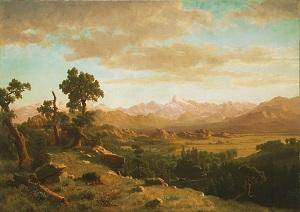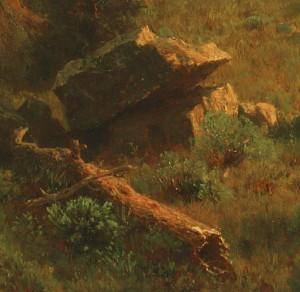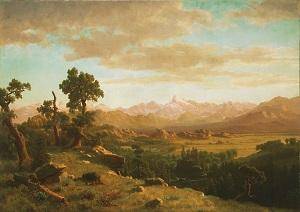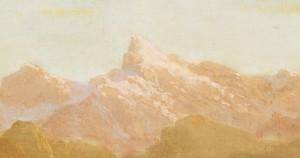Students will examine Bierstadt’s painting Wind River Country and talk about how the painting makes them feel and why. They will also learn a little bit about the historical context of the painting and use it as the setting for an adventure for which they will write a travel journal.
Students will be able to:
- explain how the artist uses light and dark areas to create certain feelings and to get the observer to notice certain items in the painting;
- state the name of the artist and the subject of the painting;
- use their imaginations for a writing activity; and
- write with enough detail and clarity to help the reader imagine what they experienced on their imaginary journey.
Lesson
- Warm-up: Have students stand in a circle. Share that you are going to tell a group story about a journey. You will start the story and turn to the student to your right, who will then say, “Yes and…” followed by his or her addition to the story. Continue adding to the story until it makes it around the circle at least once. Keep going if you have time, or perhaps even work through two stories. Encourage students to use their imaginations and share that being silly is okay.
- Show students Bierstadt’s painting Wind River Country. Talk about the artist and about the painting (refer to the About the Art section for more information). Help them examine the painting carefully and call out what they see.
- Ask students to think about what the artist does to make them feel like they are in the setting? Talk about the light and dark areas and how they are different. Look at the animals and talk about where Bierstadt placed them. Calculate the time of day.
- Tell students that they are going to imagine they are travelers during the middle 1800s, when the painting was made, and that they have to get from where Bierstadt has positioned the viewer in the painting to the mountains in the distance. They will be writing a travel journal about their adventure. They should include elements from the painting on each stage of the journey, as well as what is not pictured (e.g. animals that might be a threat such as snakes and wolves; food they might need to eat such as berries, rabbits, and fish; and water to drink, among other things).
- If time allows, have students share their favorite parts of their journals in small groups or with the entire class.
Materials
- Lined paper and a pencil/pen for each student
- About the Art section on Wind River Country
- One color copy of the painting for every four students, or the ability to project the image onto a wall or screen
Standards
- Visual Arts
- Observe and Learn to Comprehend
- Relate and Connect to Transfer
- Language Arts
- Oral Expression and Listening
- Research and Reasoning
- Writing and Composition
- Reading for All Purposes
- Critical Thinking & Reasoning
- Information Literacy
- Invention
- Self-Direction
Wind River Country
- Albert Bierstadt, American, 1830-1902
- Born: Solingen, Germany
Albert Bierstadt was born in Solingen, Germany in 1830, and was brought to New York at the age of two. He returned to Germany when he was twenty-one years old to study at the Düsseldorf Academy. Eight years later, in 1859, Bierstadt made his first trip to the Rocky Mountains when he joined a government expedition led by Colonel Frederick W. Lander (for whom Lander, Wyoming was named). Following this trip, he opened a studio in New York, where he drew from his sketches, photographs, specimens, and Indian artifacts to create large landscape paintings. Through his artwork, Bierstadt introduced Easterners to the scenery of the Rockies. While still in his early thirties, Bierstadt became one of the most successful and highly paid painters in the United States.
The Wind River Range is part of the Rocky Mountains, located in western Wyoming. Bierstadt identified the river here as the Sweetwater River, and the prominent mountain as Fremont’s Peak, known today as Temple Peak. Bierstadt liked the Wind River area enough to return there after he left the Lander expedition. As one of America’s early artist-explorers, he was looking for personal adventure and hoping to establish his artistic “territory.” The Wind River area is the subject of many of his works. Around the time Wind River Country was painted (1860), interest in the American West had reached a high point. This was in part due to western movement along the Oregon Trail; and to the writers, artists, and surveyors who had reported on the region over the past thirty years. Interest in finding American landscapes that would rival the European Alps was also growing. Bierstadt’s paintings satisfied on both counts—they delivered both heightened grandeur and specific details and places.
Details

Scale
Bierstadt liked the theatricality of a large painting. Wind River Country measures 42 ½” wide x 30 ½” tall, and some of his later pictures were four times that size. Sometimes, Bierstadt would show his work on a stage with dramatic lighting and viewers could pay admission to look at the painting with opera glasses.

Sense of Depth
Bierstadt was very interested in early photography, shooting photos on his journeys west that he could view through a stereoscope for a three-dimensional effect. Working with photographic source material in his studio may have contributed to Bierstadt’s convincing illusion of space. Looking at the mountains we can see clearly that some are close to our vantage point, while others are far away.

Light & Dark
Warm colors highlight areas touched by the sun. The viewer’s eyes are drawn to lighter areas, particularly the mountains in the distance.

Composition
Bierstadt guides the viewer through the painting by arranging elements of the scenery along diagonal lines.

Details
The foreground is full of details—carefully rendered foliage, rocks, a hollow log. In his studio, Bierstadt drew from multiple field sketches and photos to compose a pleasing picture. The scene we see here is a composite view, not an individual scene that the artist witnessed.

No Reference to Humans or Civilization
We see nature here as untouched by humans. The landscape appears rather inaccessible; there is no clear way one would be able to navigate through the scene.

Rawness of Nature
The image of a grizzly bear feeding on an antelope contributes to the sense of scale and adds drama to the scene.

The Highest Peak
Bierstadt uses several pictorial techniques to suggest the importance of the distant peak. It is placed only slightly off-center, and has framing elements on all sides—trees, clouds, and the darker mountains in front of it are parted aside. The hazy air makes the peak lighter and brighter.
Funding for object education resources provided by a grant from the Morgridge Family Foundation. Additional funding provided by the William Randolph Hearst Endowment for Education Programs, and Xcel Energy Foundation. We thank our colleagues at the University of Denver Morgridge College of Education.
The images on this page are intended for classroom use only and may not be reproduced for other reasons without the permission of the Denver Art Museum. This object may not currently be on display at the museum.







